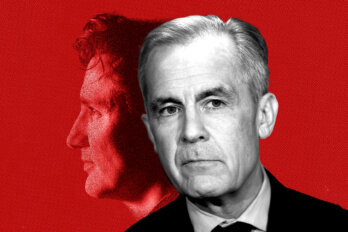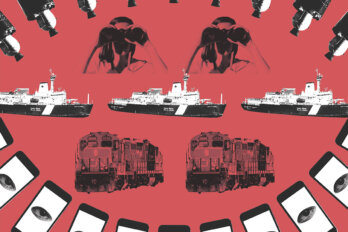I n the days after 9/11, the United States and Canada feared that another attack on the West was imminent. The George W. Bush and Jean Chrétien administrations envisaged the possibility of al-Qaeda cells operating all across North America. There was, of course, no data on whether this was the case. But what is certain is that few threats materialized for several years. In Canada, the first credible threat occurred a full five years after 9/11, with the Toronto 18 plot of 2006, which saw a group of Muslims contemplate attacks on the Toronto Stock Exchange.
In 2007, the US Department of Homeland Security still boasted that the country’s system of liberal rights and integration should be credited with preventing radicalization among US Muslims. But a steady stream of terrorist plots in the following years would belie this statement. By 2010, homeland security director Janet Napolitano affirmed that threats to national security had shifted from the foreign terrorist to homegrown radicals: “those who have lived for years in the West and who move seamlessly—often with the advantage of citizenship—in and out of target populations.”
By the time the Islamic State’s caliphate took its last breath, hundreds of Canadians and Americans had joined the jihadist organization. How do we account for this shift? What happened within Muslim communities that created the homegrown terrorist? The jihadist ideology that gave birth to the homegrown radical was, and could only have been, the product of a post-9/11 world. This is because it was a direct response to the War on Terror.
Radicalization is the greatest threat we face, or so we were told. And while national security experts have also recently labelled white supremacist groups as radical, Muslims are the original and paradigmatic bearers of this term. The post-9/11 era gave rise to the emerging discipline of radicalization studies. Experts—typically white, non-Muslim social scientists—now dedicated themselves to studying how and why Muslims became radical.
Radicalization studies emphasizes a whole host of social and individual factors that might serve as causal variables in a Muslim’s trajectory toward embracing a jihadist ideology in which violent political action is legitimated in the name of the Islamic faith. Lorenzo Vidino, director of the program on extremism at George Washington University, explains that “radicalization is the term of art used by academics and policy makers to describe the process that an individual undergoes when [he] embraces an extremist ideology, and then, in some cases . . . undertakes acts of violence in furtherance of that ideology.”
The problem with the discourse is that it hides the historical complexity of political and religious life. Radicalization studies emerged as a response to 9/11, amid concerns about understanding the jihadist enemy. Moreover, experts have often served within national security agencies like the US Central Intelligence Agency. Radicalization is a discourse in the service of the state’s management of suspect populations. How would we see it differently if we examined it not as an object located in suspect individuals but as a strategy of the state? What new histories would emerge about our post-9/11 world? What new understandings not only of Islam and jihad but also of national suspicion, policing, and violence in the US and Canada might this shift produce?
A proper historical analysis demands that, instead of sweeping our insecurities under the rug, we ask in what ways the War on Terror could be so problematic that some of our own citizens came to formulate and embrace a theory of just war against it. Acknowledging our complicity in producing violence does not excuse the jihadist. Historians who argue that the Treaty of Versailles in 1919 produced the conditions for the Second World War do not thereby justify Nazi ideology or actions. But they do add complexity to historical analysis—which is difficult when we are still party to the violence.
I n the weeks after the twin towers in New York City fell, the Canadian government made it clear that Muslim citizens were not to be blamed for the carnage meted out on Canada’s southern neighbour. In this regard, it followed the Bush administration, which called Islam a religion of sound teachings.
The government’s actions were meant to allay national anxieties about the enemy within. In the days after 9/11, suspicion of the Muslim had intensified. Fears of divided loyalties and fifth columns emerged, compounded by a legacy of orientalist stereotypes and images of brown-skinned terrorists that became fodder for countless 1980s and ’90s action movies.
But upon closer examination, it would be more accurate to say that the state sought a monopoly over the representation of the nation and the right to defend it. The government resorted to a dual strategy of publicly positioning Muslims as allies to Western civilization while privately sanctioning pervasive state surveillance of Muslim communities. The strategy reflected the government’s aim of keeping the peace at home while avoiding overt violations of the democratic and liberal values upon which Canada’s national identity and civilizational superiority had been constructed during the Cold War.
The policy protected Muslim communities from vigilante violence, which, also in the name of the nation, had begun to target mosques and Muslim individuals across North America. At the same time, it made Muslims particularly vulnerable to state forms of violence. In effect, the state arrogated to itself the right to distinguish “rational” national suspicions from excessive populist ones.
The state’s system of surveillance functioned according to a scale of suspicion. Muslims’ shared faith with al-Qaeda and the Taliban rendered them suspect by default. This suspicion was not entirely new: Muslims had already been on the radar of the Canadian Security Intelligence Service—CSIS—and the Royal Canadian Mounted Police—RCMP. Arabs were particularly subject to monitoring during the First Gulf War. After 9/11, CSIS increasingly sought to infiltrate Muslim communities by pressuring their members to become informants. And it was typically young, male Muslims who attracted especially heightened state suspicion.
By outsourcing the more unsavoury treatment of Muslims to security agencies, the state’s violence largely remained in the shadows.
C SIS was formed in 1984 in response to the discrediting of an RCMP spy division. The RCMP had come under heavy scrutiny for intrusions into civilian life. Among their offences were investigations of well-established and popular political parties like the New Democratic Party and the Parti Québécois, the former for its socialism and the latter for its commitment to Quebec separatism.
The Macdonald Report of 1981 made several recommendations to curb abuses when gathering national intelligence. Among them was that Canada’s spy agency be removed from the ambit of the RCMP and be civilianized. The consequences would be twofold. First, the intelligence agency would be led by career bureaucrats rather than trained police officers. Second, the agency’s mandate would be limited to intelligence gathering, being now stripped of the authority to make arrests.
Another recommendation was the creation of an independent oversight body that would monitor the agency’s activities and ensure it did not trespass on Canadians’ rights and freedoms. The Liberal government of the time used Macdonald’s recommendations to pass the CSIS Act, giving birth to a new spy agency. But despite these changes, CSIS ended up largely being a continuation of its predecessor. Historians characterized Canada’s new spy agency as old wine in a new bottle. Part of the reason for this continuity was that the same individuals who had led the RCMP’s spy division were now appointed to senior roles inside CSIS.
These officials traded in their police uniforms for civilian garb, but the institutional culture they knew and promoted in the RCMP came to CSIS with them—including its tendency to countenance abuse of power. A prominent example of this abuse is the case of Suleyman Goven. Goven was a Kurdish refugee who settled in Toronto in 1991. Shortly after his arrival, he co-founded and became president of the Toronto Kurdish Community Centre, which generally had favourable views of the PKK, a Kurdish organization seeking independence in Turkey.
CSIS accused Goven of belonging to the PKK and of supporting its violent tactics. But it also approached Goven with an invitation for him to work with them as an informant. They threatened to have his immigration application denied if he refused. Goven rejected the claims that he belonged to the PKK and turned down CSIS’s offer to become an informant—and, true to their word, CSIS ensured that his immigration application was denied. Goven fought for many years to have his name cleared and obtain Canadian citizenship. His case became well known to the body created to oversee CSIS’s activities, the Security Intelligence Review Committee—SIRC.
In 2000, SIRC found that there was no credible evidence Goven was ever part of the PKK. Had the story ended here, we might conclude that SIRC provided the necessary oversight to prevent CSIS’s abuses of power. But despite being proven wrong, CSIS continued to harass Goven and place considerable roadblocks on his path to citizenship. In short, CSIS attempted to coerce a vulnerable individual to become an informant, and they were vindictive when the individual refused.
In the early 2000s, journalist Andrew Mitrovica expressed doubt that CSIS could successfully defend national security while respecting Canadians’ rights in the new era of the War on Terror. Mitrovica had extensively interviewed a former agent turned whistleblower. His informant painted a picture of an agency that was both inept and deeply corrupt. He reported that illegal searches of property were standard agency practice and attested to intelligence leaks, also noting that the agency would use its funds for private ends. Further, Mitrovica rejected contentions that SIRC or the investigator general (also charged with overseeing CSIS activities) could effectively monitor CSIS, claiming that these oversight bodies were privy only to the information that the CSIS director volunteered.
If history had unfolded differently, perhaps CSIS’s abuses and corruption in the late ’90s and early 2000s would have sufficiently worried the public to push elected officials to further restructure the agency. But after September 11, 2001, politicians and the public saw CSIS as more important than ever before, and thus, sizable amounts of money were directed to its coffers. 9/11 created a perfect storm, in which an agency with a questionable track record for respecting citizens’ rights was given copious public funds and the state’s confidence to protect Canadians against foreign and domestic threats.
It is no surprise, then, that troubling reports about CSIS’s conduct during the War on Terror have emerged over the years. Judges have rebuked the agency for seeking the detention and deportation of permanent residents based on flimsy evidence. Journalists and historians have identified instances in which its information sharing has led to the imprisonment and torture of Canadians on foreign soil. And recently, former CSIS employees have sued the spy agency for the pervasive anti-Muslim racism they encountered while at work.
One former employee told the CBC that her colleagues treated her as an internal threat while she performed her duties. She reports being questioned on why she wore the hijab and being asked to undergo a lie detector test and to cut ties with her community. SIRC reports document Muslims’ experiences of feeling physically threatened, abused, and intimidated during their interactions with CSIS.
While politicians emphasized that domestic Muslim populations were not the enemy, the state nonetheless gave its security agency the power to go out and find the bad Muslims wherever they might be. Stated differently, the state gave CSIS carte blanche to live out a heroic narrative of locating the terrorist threat among a suspect Muslim population.
H ow did CSIS’s surveillance impact the Muslim population in Canada? Sociologist Baljit Nagra gives us insight into Canadian Muslims’ experiences with CSIS from 2004 to 2008. In her study of educated Muslim youth, she highlights young Muslims’ pervasive sense of being unfairly targeted. Nagra interprets this surveillance as part of a state of exception imposed on Muslims after 9/11. Muslims, according to her, were unable to fully benefit from rights afforded to fellow citizens, instead being forced to mobilize so that they might claim equal access to the Canadian nation.
In her study of Islamophobia, Under Siege: The 9/11 Generation, Jasmin Zine documents the extent and impact of CSIS’s surveillance of campuses: “surveillance campaigns,” she writes, “have targeted university campuses in ways disproportionate to demonstrated threats from these sites.” Zine documents the fears, anxieties, and self-policing that CSIS surveillance of Muslims produced. She contends that Muslims who grew up in the shadow of 9/11 came to experience their presence in Canada as “a problem” for the Canadian multicultural nation.
CSIS’s attitudes toward Muslims in the post-9/11 era cannot be divorced from widespread anti-Muslim racism in North America. The suspicion and violence against Muslims during the War on Terror reveal something about our deep-seated national fears. The “enemy within” raises the spectre that perhaps nothing is really holding the nation together. In times of war and peace, the state’s function is to define the nation by mobilizing symbols and instituting practices that can sufficiently justify the notion of a united people. In effect, the state needs to continually reimagine the national community.
The assumption is that liberal democratic states have met this challenge by building multi-ethnic nations premised primarily upon political rights rather than language, race, or religious background. But the War on Terror suggests that the language of political values is still deeply wedded to a racial- and territorial-origin story. The liberal and democratic rights that are meant to bind us together are tied to a civilizational project with deep colonial roots that saw white Europe as the natural teacher to the colonized “savages” of the non-European world.
I have little doubt that someday there will be deep national contrition for the treatment of Canadian and American Muslim citizens during the War on Terror. But we are not there yet.
Adapted and excerpted from Homegrown Radicals: A Story of State Violence, Islamophobia, and Jihad in the Post-9/11 World by Youcef Soufi, published by the University of Regina Press. Copyright © 2025 Youcef Soufi. All rights reserved.




